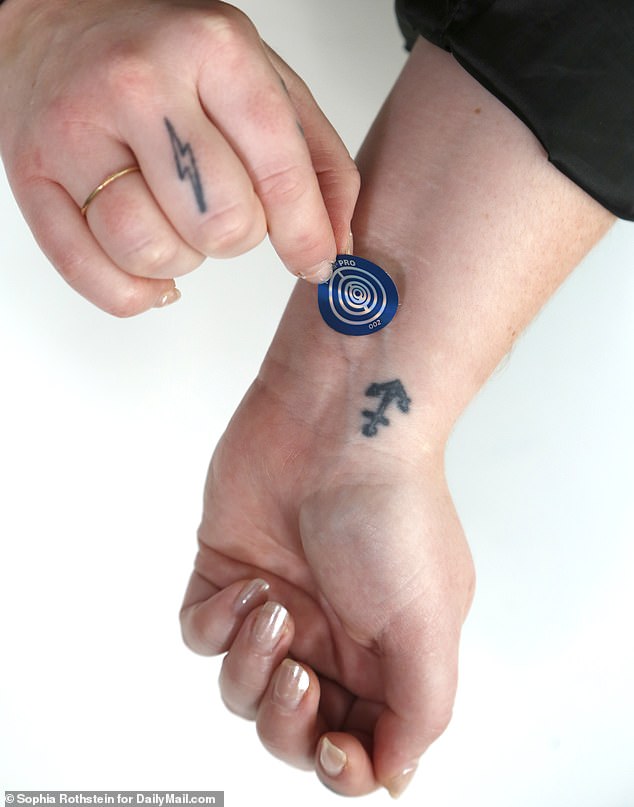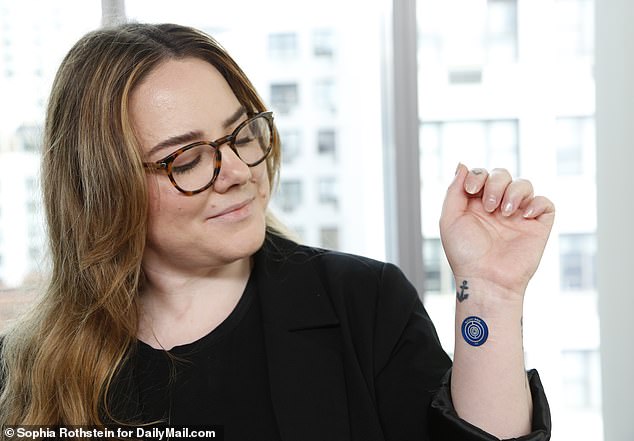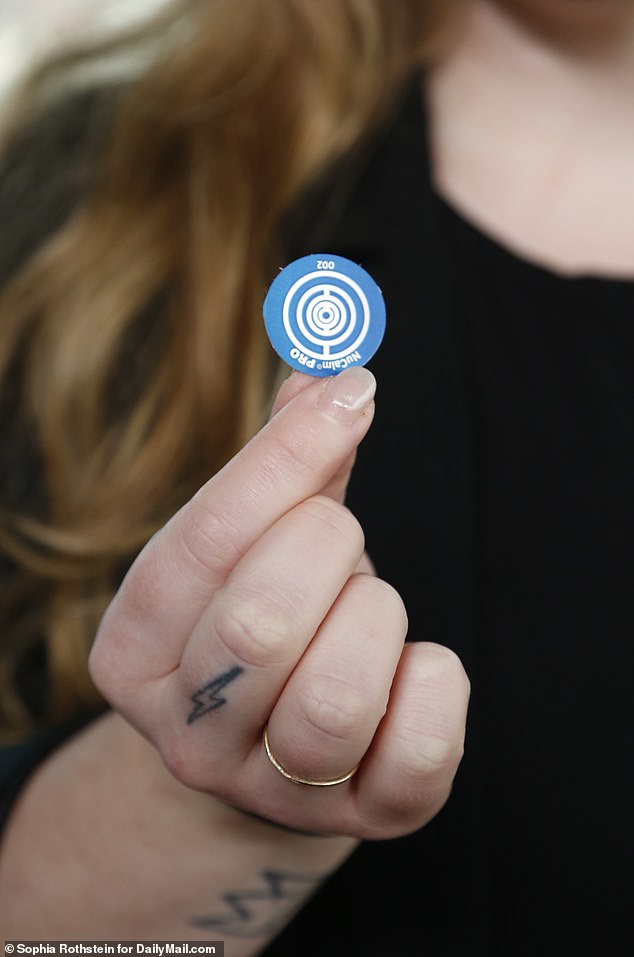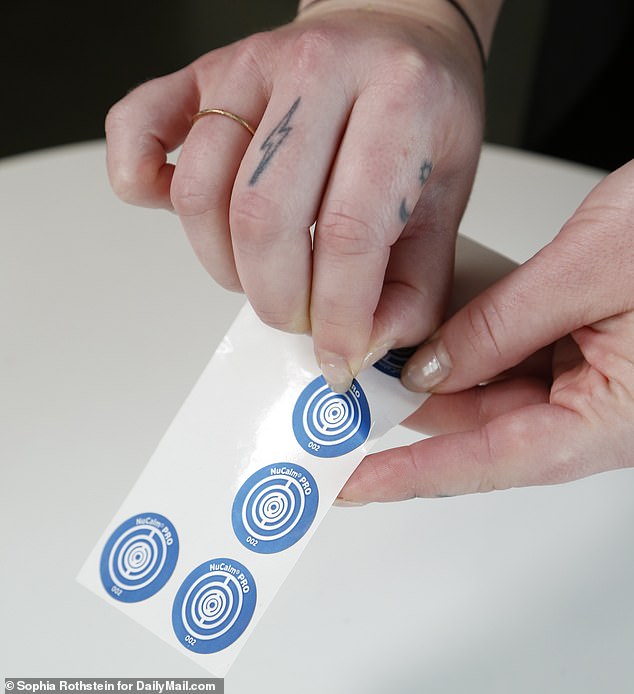I wore Meghan Markle’s $80 anti-stress patches for 10 days – here’s what happened
Then Meghan Markle got out in a $1,600 wool coat, Hermes scarf and Chanel flats last month, it wasn’t her outfit that turned heads.
Her most talked-about accessory was a small blue sticker on her left wrist: an anti-stress NuCalm patch that has become popular among wellness gurus and biohackers and promises to provide “resonance and frequencies.”
As a person with high stress levels, I was immediately intrigued and willing to pay the $80 for a pack of 20 NuCalm stickers (plus the $30 per month for the company’s companion app).
If it’s good enough to keep the Duchess of Sussex calm, I thought it would be an easy counter to my daily stressors.
Meghan Markle was spotted wearing the anti-stress patch in August

DailyMail.com tested the anti-stress patches for over a week. The discs, in combination with the NuCalm app, had a marginal benefit for sleep, but overall the effects appeared to be placebo

When the sticker is placed on the inside of the left wrist, at the Pericardium-6 acupuncture point, the sticker sends a signal to the protective sac surrounding the heart, called the pericardium, which activates the parasympathetic nervous system to stimulate the natural response of the heart. body to disrupt external stress.
When I went to NuCalm’s website to find out what to expect, I was confronted with jargon that only meant a Ph.D. student could understand.
The site said the sticker works by “tapping the body’s pericardial meridian with certain electromagnetic frequencies of inhibitory neurotransmitters to interrupt the HPA axis and decrease sympathetic tone.”
Will you come again?
I couldn’t help but feel that the jargon was meant to mask the fact that the sticker is based on traditional Chinese medicine rather than sound science.
For ten days I wore the sticker on the ‘pericardium-6 acupuncture point’, which is a fancy way of saying the inside of my left wrist.
In traditional Chinese medicine, this pressure point is said to be part of the ‘Pericardium Meridian Energy Path’ which, when stimulated by acupressure, can influence the flow of vital energy or ‘qi’ and blood along that path.
If you’re rolling your eyes while reading that description, you sound like me. But during the first two days of my trial, I was surprised by how much I felt the reduction in overall stress.
Whether it was a placebo effect or pure optimism about a possible anxiety treatment that isn’t a pill made by big pharmaceutical companies, I’m still not entirely sure.
When you wear the sticker, you get a slight feeling of pressure on your wrist, which took some getting used to.
After about day three, and I started to forget the sticker was there, the stress and anxiety returned – which gives me confidence that there is something psychosomatic going on when it comes to NuCalm’s anti-anxiety effects.
There were long periods during the test where I noticed that my breathing felt smoother and more consistent than normal. But then again, was I just being overly sensitive to my body? I still haven’t figured it out.

The disc aims to harness the body’s natural frequencies and vibrations to induce a feeling of calm and relaxation

For $80 worth of stickers and $30 for the companion app, DailyMail.com didn’t think there was a measurable benefit
As the week went by, I felt a recurring sense of unease: waiting on the claustrophobic subway platform during rush hour or holding my breath on the phone as the dial tone buzzed, hoping that my source was on the other end. would pick up from the line.
But every now and then, when I saw the sticker on the inside of my wrist again, my breathing would become easier, my thoughts would slow to a normal pace, and my muscles would loosen.
It was as if the sticker was a reminder instead of an actual medical device.
I tried to dig up some scientific research that could answer my question: Was it all in my head?
But the answer eluded me, even after following up on the NuCalm website’s repeated claims that it was “clinically proven.”
I have found no such clinical trial or research on any wearable biosignaling drive.
When it comes to sleep quality, I felt slightly more rested over the 10 days.
The NuCalm Deep Sleep channel in the app offers music that can play for hours, although it’s not the actual music that puts you to sleep.
The frequencies of the music are said to synchronize brain waves with other frequencies associated with different states of being – alpha and theta, which mimic the body’s natural communication processes to initiate sleep.
The difference after wearing the disc overnight and listening to low frequencies for hours was marginal, although I did notice that I hit the snooze button less often, which indicated that the quality of my sleep had improved.
Given the flawed science and lukewarm reviews from neuroscientists, it’s worth dissecting the company’s claims.
The company likens the small disk in each sticker to a battery containing a charge.
When the sticker is pressed against a pressure point, the body draws out energy frequencies that activate the part of the nervous system that modulates our responses to stress.
The question of what exactly is in this drive that creates the kind of communication between neurons that the company prides itself on remains a bit murky.
The company credits frequency tuning and sound resonance for making its discs work, but elsewhere on the site it says the discs “contain a proprietary blend of inhibitory neurotransmitters, primarily GABA.”
But elsewhere, NuCalm CEO Jim Poole says the drives each contain a small Tesla coil to transmit frequencies.
The technology was developed over a period of twenty years by the late neuroscientist Dr. Blake Holloway.
But Mr. Poole is not a scientist himself, he was previously a majoring student at Babson College in Massachusetts.
Sophie Summers, a blogger at the Fitness Junkie Blog, said of her experience with a 30-minute meditation session via the app combined with the sticker on her wrist: ‘As the beautiful sounds swirled around me, I felt my whole body relax.
‘It was as if I could feel my whole body as one whole, but also parts of it separately. My whole body, but especially my arms and chest, became very heavy.
‘The thought of moving my arms seemed like an impossible task. But the feeling was so wonderful that I didn’t even dare to try it, for fear of losing the deep relaxation.
‘I was calm, relaxed and grounded.’
The price tag is unlikely to deter people who pride themselves on being in tune with their personal health, nor will the lofty promises deter so-called wellness gurus who have successfully cashed in on the quest for self-improvement.
